|
|
|
Sort Order |
|
|
|
Items / Page
|
|
|
|
|
|
|
| Srl | Item |
| 1 |
ID:
117107


|
|
|
| 2 |
ID:
109548
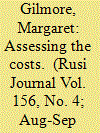

|
|
|
| 3 |
ID:
166929
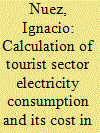

|
|
|
|
|
| Summary/Abstract |
The Canary Islands is a European archipelago whose principal economic activity is international tourism. Due to its geographic isolation, it does not have any connection with continental electricity grids. The Spanish state subsidises the extra cost of electrical energy generation in isolated systems. The purpose of this study is to quantify the proportion of the electricity bill that corresponds to tourist activity that is being subsidised. With this aim, three complementary methodologies have been developed. These tools could also be used in similar environments. The results reveal an average tourist sector consumption in the study years (2014–2017) between 12.8% and 16.5% of the total amount of electricity generated in the archipelago, with a monetary value of Spanish state subsidy estimated in €143.5 M in the year 2014. Additionally, a calculation was made of the values of CO2 emissions due to tourist electricity consumption for the years of the study period, with an estimated peak of 1.1 MtCO2 in 2017. From the point of view of energy policy, these results could be used to justify the adoption of various types of compensatory measures, including ecotaxes to be paid by the tourist visitor.
|
|
|
|
|
|
|
|
|
|
|
|
|
|
|
|
| 4 |
ID:
134024


|
|
|
|
|
| Publication |
2014.
|
| Summary/Abstract |
Collaborative defence projects have been a distinctive feature of European defence industrial policy. This article focuses on whether the number of partner nations in international collaborative defence and aerospace programmes is a source of inefficiency. It appears that there is not a simple linear relationship. Two nation collaborations can be efficient, but conventional wisdom assumes that inefficiencies emerge with more than two partner nations. Inevitably, data problems made what appears to be a simple hypothesis difficult to test. The major result is that there is no evidence that efficiency as measured by development times is adversely affected by the number of partner nations. A limited sample regression and a comparison of Airbus vs. Boeing shows a similar conclusion.
|
|
|
|
|
|
|
|
|
|
|
|
|
|
|
|
| 5 |
ID:
190438
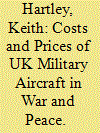

|
|
|
|
|
| Summary/Abstract |
Much of the literature on military aircraft unit costs is based on US data. This article adds to our knowledge by using an original data set for UK military aircraft costs, profits and prices. A distinction is made between unit costs within a generation of aircraft and between generations. Four research questions are addressed. First, is the UK aircraft industry a decreasing cost industry; second, are new entrants higher cost suppliers; third, what is the evidence on profitability in war and peace and between new entrants and original developers; fourth, what is the UK evidence on Augustine-type cost escalation and on the efficiency of aircraft procurement in war and peace? The UK aircraft industry was found to be a decreasing cost industry reflecting both scale and learning economies. Typically, new entrants were higher cost suppliers and profit rates were higher in peace-time. There was substantial Augustine cost escalation for UK combat aircraft and doubts are raised about the efficiency of military aircraft procurement.
|
|
|
|
|
|
|
|
|
|
|
|
|
|
|
|
| 6 |
ID:
148069
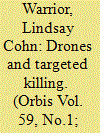

|
|
|
|
|
| Summary/Abstract |
There is widespread interest in how armed drones are used, how targets are chosen, and what frameworks of legality and political accountability exist. Less addressed is how use, targeting, justification, and accountability affect the people and the organizations being asked to operate the drones. This article examines the costs to the operators and the military organization of increased reliance on drones. It argues that the government and the public need to come to terms with the human costs—both foreign and American—of increased use of unmanned systems. It concludes that the government needs to find a way to make its employment of drones transparent and accountable enough that it will not harm the overall well-being, morale, and loyalty of the force.
|
|
|
|
|
|
|
|
|
|
|
|
|
|
|
|
| 7 |
ID:
111410


|
|
|
|
|
| Publication |
2012.
|
| Summary/Abstract |
Over half of U.S. states have renewable portfolio standards (RPSs) mandating that a minimum percentage of electricity sold derives from renewable sources. State RPSs vary widely in how they attempt to control or limit the costs of these RPSs. Approaches utilized include alternative compliance payments, direct rate caps, and cost caps on resource acquisitions, while some states employ no specific limitation at all. This paper describes how states attempt to control RPS costs and discusses the strengths and weaknesses of these various cost controls. There is no one best method; however the experience to date suggests that the most important factors in implementing an effective mechanism to curtail costs are clarity of the rule, consistency in application, and transparency for customers.
|
|
|
|
|
|
|
|
|
|
|
|
|
|
|
|
| 8 |
ID:
125749


|
|
|
|
|
| Publication |
2013.
|
| Summary/Abstract |
This study focusses on the estimation of power interruption costs to industries in Cameroon. Those interruptions are the result of perturbations sustained by the power network. A normalised direct worth (NDW) approach was used as a direct method for assessment, while the compensatory estimation method (CEM) was used for indirect assessment. A survey was conducted with a representative sample of industries in Cameroon using a questionnaire as the main research instrument. The results show that power interruption losses are very significant. Using the direct method for assessment, the average outage cost varies from €3.62/kWh to €5.42/kWh for a 1-h interruption and from 1.96/kWh to €2.46/kWh for a 4-h outage. The study finds that advance suspension notices could help in reducing outage costs by 19.83-33%. With the indirect method, the total capital costs and total running costs of generators are approximately €180,040,180.08 and €4,305,510.6, respectively, while the average cost per unused kWh of electricity stands at €3.37/kWh. The study concludes that power interruptions have a significant negative effect on industries in Cameroon.
|
|
|
|
|
|
|
|
|
|
|
|
|
|
|
|
| 9 |
ID:
166999
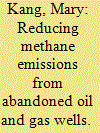

|
|
|
|
|
| Summary/Abstract |
Well plugging, the main strategy for reducing methane emissions from millions of unplugged abandoned oil and gas (AOG) wells in the U.S. and abroad, is expensive and many wells remain unplugged. In addition, plugging does not necessarily reduce methane emissions and some categories of plugged wells are high emitters. We analyze strategies and costs of five options for reducing methane emissions from high-emitting AOG wells - those which are unplugged and plugged/vented gas wells. The five options are: plugging without gas venting, plugging with gas venting and flaring, plugging with gas venting and usage, gas flaring only, and gas capture/usage only. Average plugging costs ($37,000 per well) can be justified by the social cost of methane, which considers air quality, climate, and human/ecosystem impacts. Savings as measured by natural gas prices and alternative energy credits can offset low plugging costs (<$15,400 per well) but are not large enough to offset average plugging costs. Nonetheless, reducing methane emissions from AOG wells is a cost-effective strategy for addressing climate change that has comparable costs to some current greenhouse gas mitigation options and can produce co-benefits such as groundwater protection. Therefore, we recommend including the mitigation of AOG wells in climate and energy policies in the U.S., Canada, and other oil-and-gas-producing regions.
|
|
|
|
|
|
|
|
|
|
|
|
|
|
|
|
| 10 |
ID:
162324
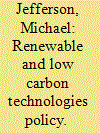

|
|
|
|
|
| Summary/Abstract |
Over the past twenty years there has emerged widening interest in shifting to a lower carbon world. This has primarily been motivated by fears of human-induced climatic change, growing risks to sustainable development, concerns about the continuing availability and affordability of useful energy, and opportunities for investment gains.
|
|
|
|
|
|
|
|
|
|
|
|
|
|
|
|
| 11 |
ID:
113794
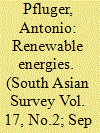

|
|
|
|
|
| Publication |
2010.
|
| Summary/Abstract |
Energy efficiency and energy conservation are the cornerstones of win-win strategies for reducing emissions while fostering economic development. Renewable energies can technically contribute to practically all sectors of energy demand, that is, fuel for transportation, electricity, low temperature heat for space heating and hot water and, to a limited degree, to high temperature process heat. However, costs and variability are the two major security concerns regarding renewable energies. An improvement of energy security by using renewable energies is possible but it causes additional costs. However, a sufficiently widespread variety of energy sources implies the acceptance of a certain spread of costs in any case. This means that efforts to improve energy security do not come for free. More secure energy systems require higher costs and thus, higher energy prices.
|
|
|
|
|
|
|
|
|
|
|
|
|
|
|
|
| 12 |
ID:
172145
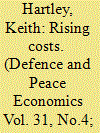

|
|
|
|
|
| Summary/Abstract |
Rising military equipment costs were famously identified by Norman Augustine with forecasts of a single aircraft air force by 2054. This paper presents and analyses an original data set for UK military aircraft. It provides evidence on cost escalation for various UK aircraft types comprising fighter/strike, bombers, military transports, maritime patrol aircraft, helicopters, trainers and civil aircraft. Continued cost escalation is identified for almost all types but with different cost escalation factors. It is concluded that the specific Augustine hypothesis of costs rising by a factor of four every 10 years might be an under-estimate.
|
|
|
|
|
|
|
|
|
|
|
|
|
|
|
|
| 13 |
ID:
095045


|
|
|
|
|
| Publication |
2010.
|
| Summary/Abstract |
This paper defines the global economic costs of conflict and suggests two key criteria, namely comprehensiveness and consistency, which are necessary for a valid calculation of such costs. A critical review of the literature reveals that most studies focus on national income losses, using counterfactual regression models, finding a negative impact on growth both for conflict countries themselves and for their neighbors. However, the debate is quite fragmented and the literature fails to combine these insights in a comprehensive and consistent manner. Furthermore, there is little work thus far on integrating aggregate and micro-level estimates of the costs of conflict.
|
|
|
|
|
|
|
|
|
|
|
|
|
|
|
|
|
|
|
|
|